
Text © Prof. Pietro Pavone

English translation by Mario Beltramini
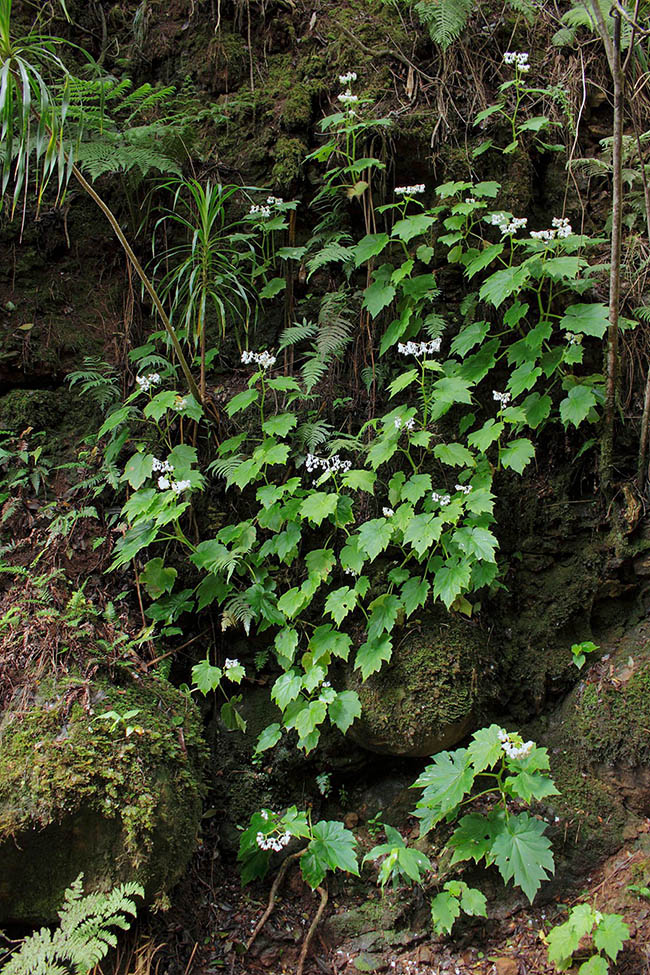
Begoniaceae family counts only 2 genera: Hillebrandia growing with one species, H. sandwicensis here shown, in the humid and deep ravines of the Hawaiian rainforests, and Begonia that has more than 1870 species © Karl Magnacca
The name of the family Begoniaceae C. Agardh (1824) comes from the genus Begonia dedicated by Charles Plumier (1646-1704), French botanist of the order of the Minims, to Michel Bégon (1638-1710), naturalist and high official of Louis XIV, intendant of the French West Indies and of France (Rochefort and La Rochelle.
In the past, this family of plants belonged to the order Violales with twelve genera, but recent phylogenetic, morphological and molecular studies have included the Begoniaceae in the order Cucurbitales (APG IV, 2016) with only two genera: the genus Hillebrandia with the only species H. sandwicensis Oliver, endemic to the Hawaii Islands, and Begonia, with species widely distributed in the tropical and subtropical regions of the whole world, but Australia.
The family counts monoecious, rarely dioecious, species, characterized by annual or perennial herbaceous plants, at times shrubby or climbing.
They present succulent and elongated stems, at times woody or reduced to tuberous rhizomes. The leaves are simple and alternate (spirally arranged), petiolate, with commonly asymmetric laminae, entire, lobate, palmate or costapalmate, with entire or serrate margin, sometimes provided of starred or scaly hairs, and with usually deciduous stipules, rarely persistent.
The fruits are grouped in unisexual or bisexual inflorescences, axillary, occasionally terminal, mostly dichotomic or symmetric cymes, at times racemes, rarely with solitary flowers, at times with reduced axes, nodes with persistent or deciduous bracts.
They are epigynous, unisexual, actinomorphic or zygomorphic flowers.
Their perianth is homochlamydeous, that is presents sepals and similar petals (tepals), free or merged at the base (connate).
Usually, the male flowers have 2 + 2 [5 + 5] elements, the female flowers are normally 5 [5 + 5] and imbricate, at times with 2-6 [-9] free or partially fused perianth.
The stamens are usually numerous with free or merged filaments. The anthers are bicellular, apical or lateral, with poricidal dehiscence.
The gynoecium is syncarpous, with an inferior ovary (in Hillebrandia semi-inferior), often winged, divided in (1-) 2–3 [–6] cavities with septa at times incomplete and axillary placentation, rarely parietal. The styles are in the same number as the carpels and bear bifurcate stigmata and twisted in some taxa [e.g. Begonia formosana (Hayata) Masam.]. The ovules are anatropous and numerous.
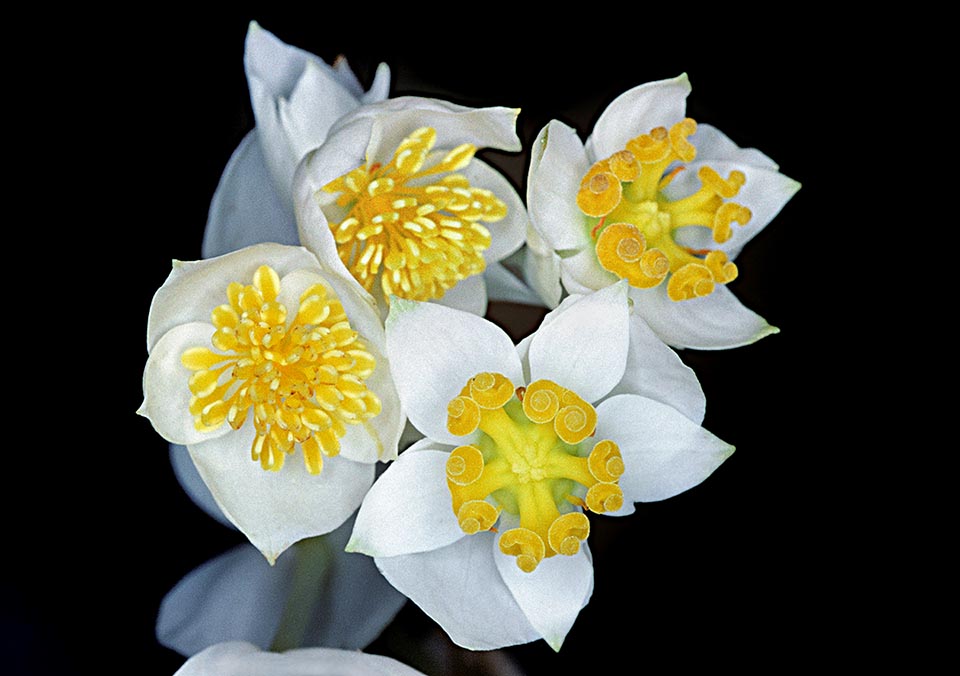
Hillebrandia sandwicensis has on the same plant male flowers, left, overflowing with stamens, and female ones, right, with showy bifid styles having 5 helical stigmas © John Game
Most species of Begonia have regular open flowers that are pollinated by small bees and other generalist pollinators.
Some species have campanulate ot tube-like flowers for the pollination done by birds like the species of the sectn. Casparya of the Andes Cordillera in Colombia and those of the sectn. Symbegonia of New Guinea. These species operate a double deception because neither the male flower nor the female one offer a reward of nectar and the pollen is not utilized as food for the birds. Only Begonia ferruginea L.f. (section. Casparya ) produces nectar in the female flowers, the only case known in the family.
The fruit is a capsule, usually with three wings, at times with one more prominent than the other two like in Begonia chuyunshanensis C.I Peng & Y.K.Chen.
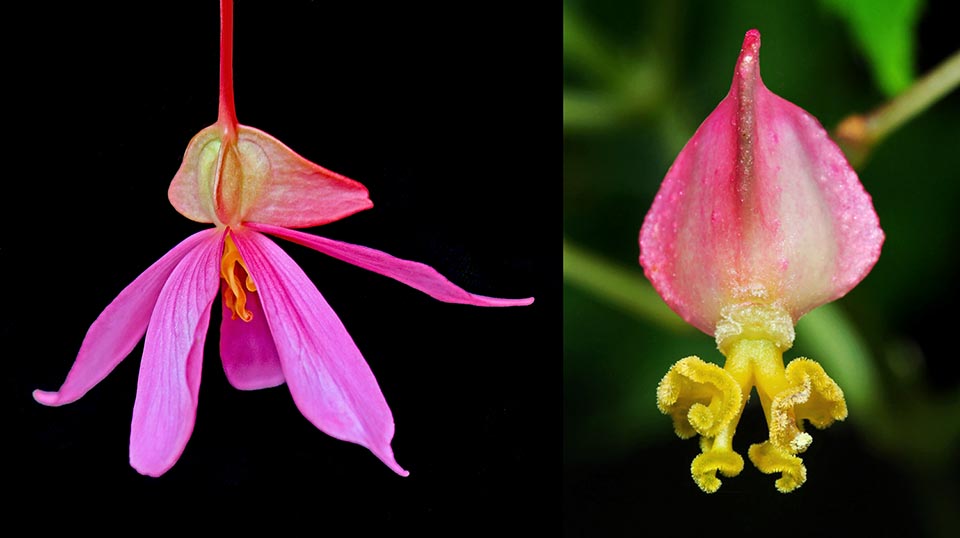
Also in genus Begonia the flowers are unisexual, but petals and sepals, called tepals, are similar and the ovary is inferior. Left, Begonia pendule female flower with three-winged ovary, one of which is bigger. Right, female flower with fallen perianth of Begonia formosana, with two bifid styles surmounted by spirally banded yellow stigmas © René Van Wallendae (left) © Chi Ying Lee (right)
The dehiscence can be loculicidal or septicidal, and rarely produce indehiscent fruits, in some species they are fleshy berries like in B. salaziensis (Gaudich.) Warb. endemic to the Mascarene Islands. The fruits contain numerous seeds (25-100 or more), small, oblong, reticulate, with a ring of cells under the micropyle acting as operculum during the germination. The embryo is straight with inconsistent or absent endosperm.
The family includes one of the largest genera of Angiosperms in the world. As a matter of fact, the genus Begonia, with its 1870 species subdivided in eighty-one sections, is present in Mexico, West Indies, Central America, South America, Asia, Africa, Indian Ocean islands, Pacific islands (Hawaii). Some species are usually terricolous living on humid rocks, along water streams, on the forests soil or on rocky cliffs; only a few ones are epiphyte.
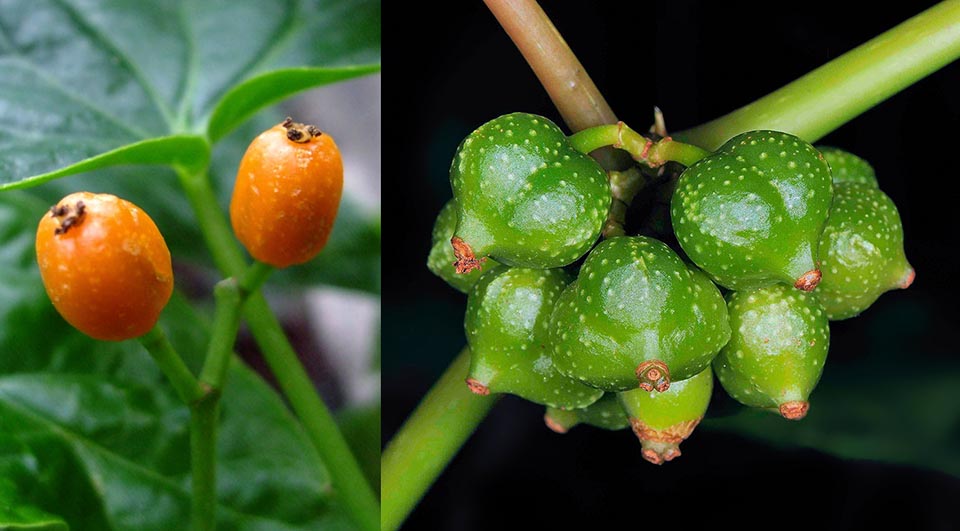
Fruits can be dehiscent or indehiscent. Left, the berry-like ones of Begonia salaziensis, right the Begonia aptera globose, bacciform capsules without wings © @twacar (left) © Ming-I Weng (right)
The greatest diversity of this genus stands in Asia with more than 750 species and in Central and South America with about 600 species, whilst in Africa there are present about 160 species.
The ancestors of the family Begoniaceae, due to the scarce fossil documentation, are little known. The genetic and phylogenetic techniques that utilize genetic markers, associated with morphological characters and the cytological techniques such as the visualization of the mitotic or meiotic chromosomes, have remarkably increased our knowledge about the diversity of the genus Begonia.
The geographical origin of the family has been uncertain for a long time, mainly due to the presence of the genus Hillebrandia, geographically isolated in the Hawaii Islands.
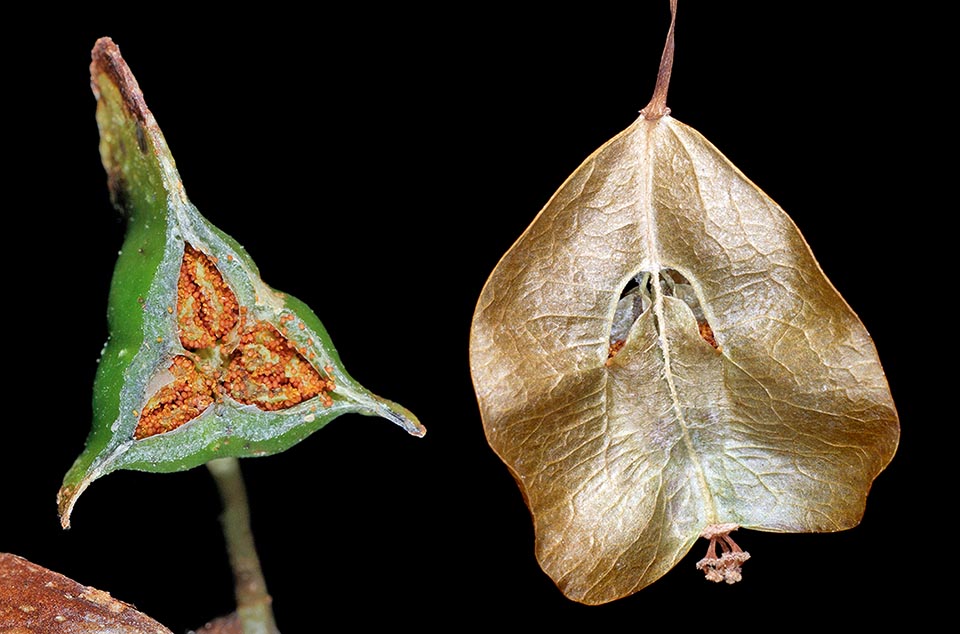
Seeds are very numerous. Left, a dissected capsule of Begonia chuyunshanensis; right they get out from a ripe loculicidal capsule of Begonia maculata © Ming-I Weng (left) © Giuseppe Mazza (right)
The temporal estimates indicate an Eocene origin (about 40-60 million of years ago) with a possible common ancestor diffused in Eurasia, even if the diversification of the group probably dates to the Oligocene (about 23-24 million years ago). Recent studies in the phylogenetics of the genus Begonia suggest that it originated in the African continent, long after the breakup of the supercontinent Gondwana.
It is probable that the two genera did separate about 24,6 million years ago, that is during the Oligocene, when a suitable climate got available in the Hawaiian archipelago.
The Hawaiian distribution of Hillebrandia is better explained if we hypothesize one single dispersion from Africa to Hawaii. Similarly, Begonia from Africa has dispersed, independently, in America as well as in Asia during the last 20 million of years, a period climatically more plausible for these events of dispersion.
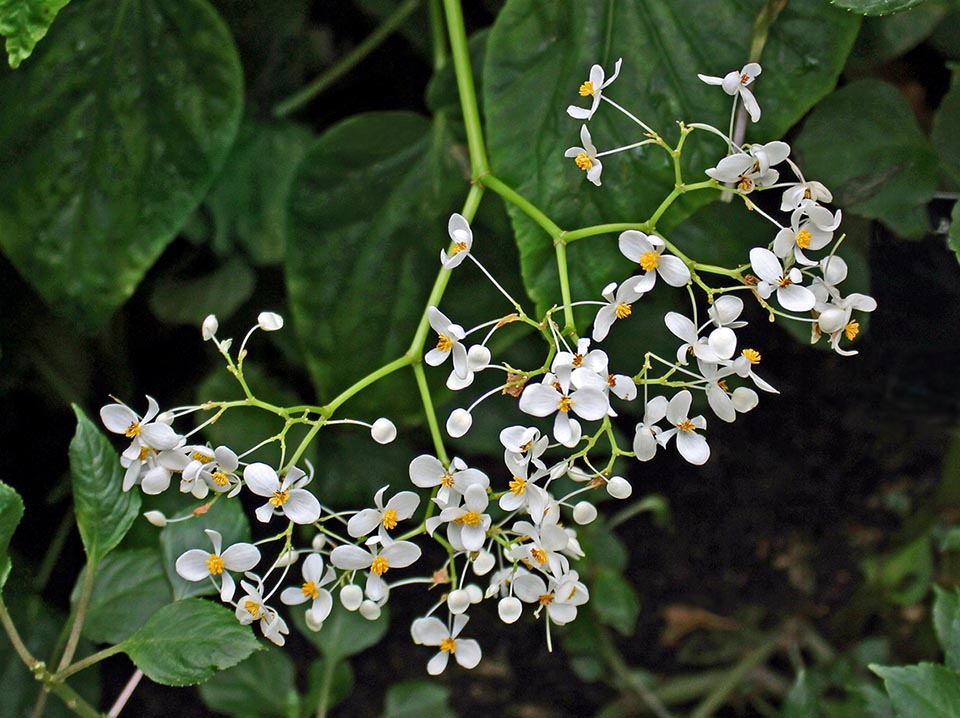
Various Begoniaceae have medical virtues. Begonia malabarica, present in India and Sri Lanka is used as anti antimicrobial on wounds, against hypoglycemia and anemia © Ruud de Block
There are proofs that the African species of the sections Rostrobegonia, Sexalaria, Augustia and Peltaugustia are phylogenetically related to the Asian and American species and display adaptations to seasonally drier climates.
The dispersion in Asia might have occurred by land because the long-range dispersion has been rarely noted in the genus Begonia. It is thought, however, that the migration in Asia did occur through the Arabian Peninsula during a warm and humid climate peak of the Middle Miocene (17-15 million of years ago).
This hypothesis is consistent with the phylogenetic analyses and the reconstructions of the ancestral areas of Begonia in Asia that indicate an initial diversification through southern India-Sri Lanka, Socotra and finally continental Asia, to colonize, later on, from west to east, the Malay Archipelago.
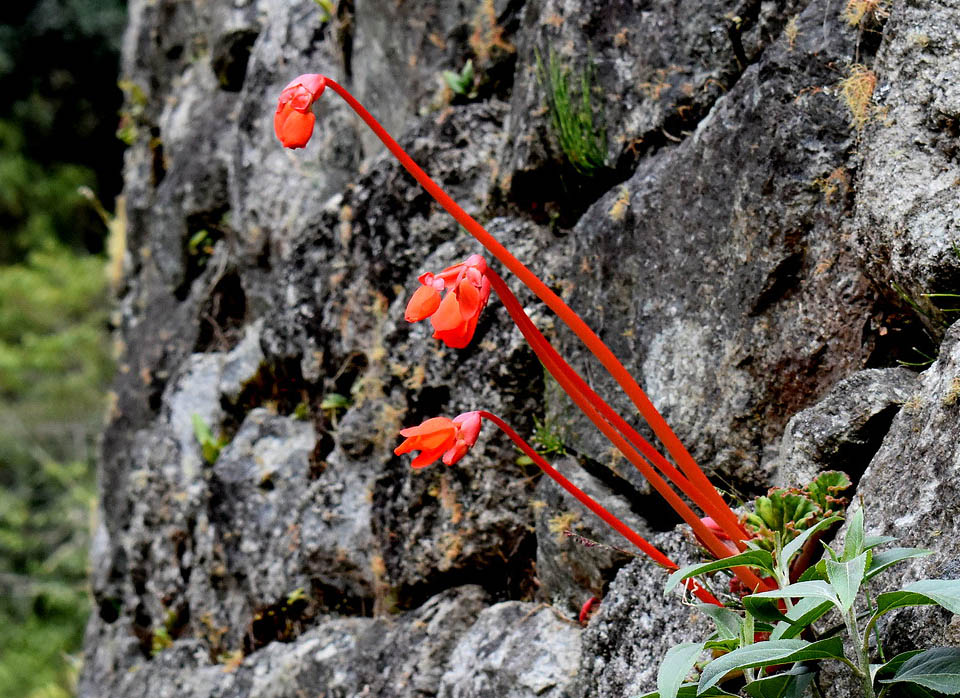
Begonia veitchii has edible rhizomes. The decoction is used in Peru as urinary, intestinal and hepatic anti inflammatory, but also, with empty stomach, as laxative © Giuseppe Morlando
The diversification of the genus Begonia, in south-east Asia, might have been accelerated by the raising of the mountains in the Pliocene and by the repeated glaciations in the Pleistocene (from 2,58 million years ago to 11.700 years ago), with variations of the sea level. However, the species of Begonia could not cross the Torres Strait, of only 150 km, between New Guinea and Australia not even during its emergence in the Pleistocene as well as not when the sea came back to occupy the Strait from 12.000 to 8.000 years ago. Finally, the reduced number of species in Africa can be considered, but not completely, by admitting their extinction due to the climate changes of the Pleistocene.
The presence of a greater number of species only in some African areas leads to hypothesize that the most vulnerable species did survive the climate variations of the glaciations, remaining relegated in areas of refuge and when the climate did improve, they dispersed outwards. It is probable, then, that the present regions with a high number of species of Begonia are former refuges.
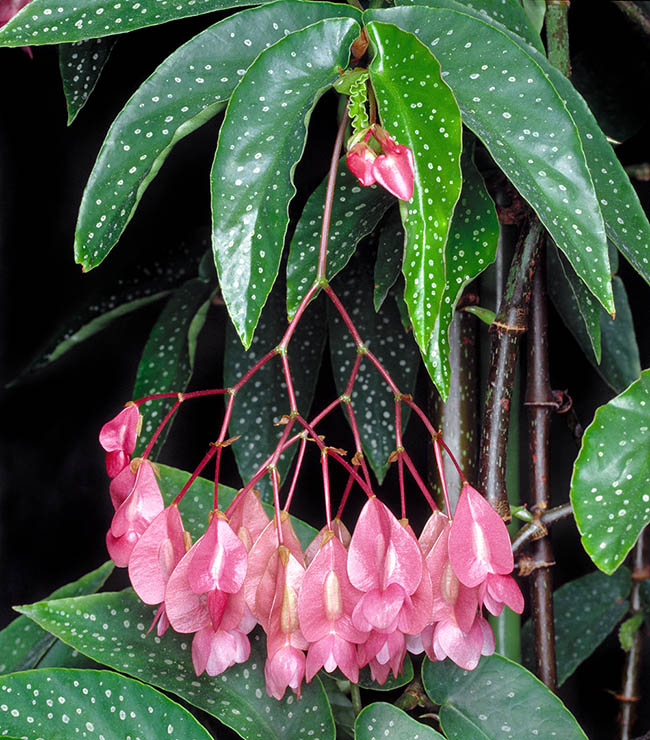
Native to Brazil, Begonia maculata has tall and woody stems with prominent articulations, resembling bamboo © Giuseppe Mazza
Furthermore, most African sections are well circumscribed and seem to present monophyletic taxa, but the section Mezierea that is polyphyletic.
The presence in Madagascar of about 50 species, almost all endemic, with the only species Begonia oxyloba Welw. ex Hook.f., present also in the African continent, suggest that Begonia in Madagascar can be the result of one single event of dispersion from continental Africa and a subsequent radiation in the island.
Cariologic data reveal that the genus has a very dynamic genome, with variations of the number of chromosomes and of their average dimensions, and a different chromosomic structure, even if between strictly correlated species. The presence of particular chromosomic numbers is important for predicting the reproductive barriers between the species and the potential fertility of the hybrids and can be indicative of a strict evolutive relation.
In Begonia have been found somatic chromosomic that vary from 2n=16 in B. rex Putz to 2n= 156 in B. acutifolia Jacq. Between these extremes has been described a wide range of chromosomic numbers. Many species or cultivars display chromosome numbers of 2n = 26 or 28 (x = 13 or 14) or multiples of these numbers. The tuberous horticultural American begonias, derived from interspecific crosses present chromosomic numbers 2n = 27 and 28 (diploid), 41 and 42 (triploid), 52 and 56 (tetraploid).
In the Asian begonias, the most frequently observed chromosomic number is 2n = 22 (x=11) (Section Platycentrum and Sphenanthera), whilst the chromosomic number base x=15 may be considered as ancestral with diploid derivatives (2n = 30) or triploid (2n = 45). In western Africa a considerable number of species presents 2n = 38 (Section Scutobegonia and Tetraphila) and in eastern Africa we find the numbers 2n = 22, 26 and 28 (Sectn. Augustia and Rostrobegonia) with prevalence of the number 26 and with the only exception of B. wollastonii Baker f. (= B. keniensis Gilg ) with 2n = 38 that is thought to have triploid origin.
The high number of chromosomes is due to the polyploidy that can give origin to morphological innovations and consequently to new species. The polyploids can form because of somatic mutations, in meristematic cells, or in the gametes that keep not reduced (2n) due to absence of meiosis. In fact, it has been generally accepted that rightly the gametes 2n may be the cause of the formation of the polyploid in nature.
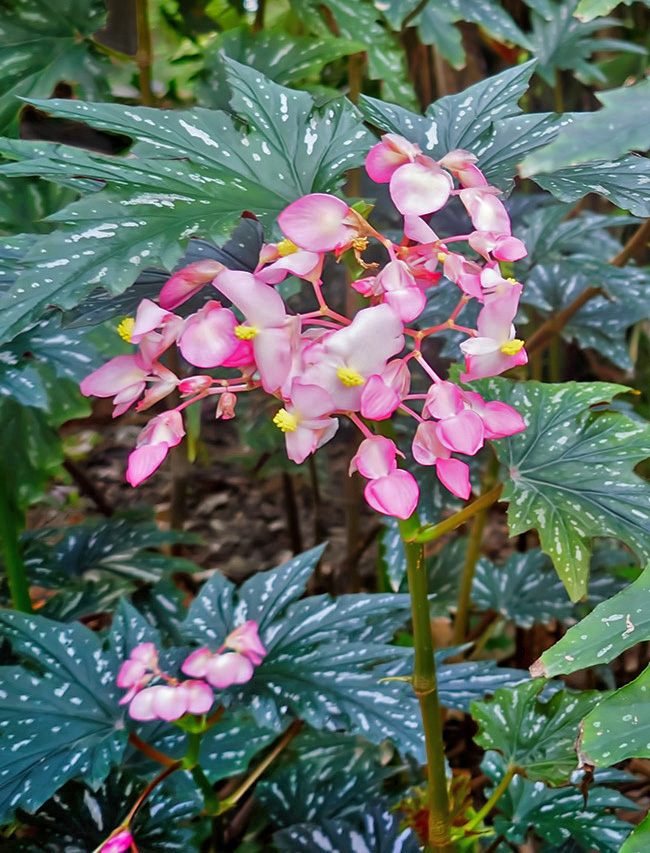
Also the Begonia aconitifolia, known in cultivation as “metallic begonia”, belongs to the Cane-like begonias group © Manuel Hernández
The family Begoniaceae numbers many endemic species that are elements that more than others characterize the flora of a particular geographical district. They are exclusive entities for their adaptive strategies but are also the most fragile elements, exposed to risk of extinction for various causes. Their disappearance would cause the loss of biodiversity that could never be recovered or built again. The genus Begonia, in the only China, of 173 species has 141 endemics, in Madagascar, on 50 species, 48 are endemic and so on for the other territories.
As the anthropic pressure during the last years has more and more increased due to the multiple uses of these plants, the International Union for the Conservation of Nature, (IUCN), has inserted the most species in the “Red List”, in order to limit this phenomenon. Presently, the genus Begonia has 74 species inserted in the list. And, precisely: one species is already extinct (EX) B. eiromischa Ridl., nine are in critical danger (CR), twenty-seven in danger (EN) and thirty-eight are vulnerable (VU).
The genus Hillebrandia, with the only species H. sandwicensis, is not included in this list even if presenting reduction of its natural range, deserves, therefore, the insertion in the IUCN to limit the risk of a possible extinction. To raise the awareness among the competent bodies, we cite here below some information concerning this interesting endemism.
Hillebrandia sandwicensis Oliv. is a species exclusive of the three Hawaiian Islands Kawai, Maui and Molokai and grows in humid and deep ravines in the shade of a dense rainforest at altitudes between 900 and 1.800 m. It is a herbaceous species with fleshy ramified stems that rise from underground rhizomes and may reach one metre of height. The leaves, on long petiole, are weakly asymmetric, bilobate, hairy, with palmate veins of glossy green colour. The flowers, in cymose inflorescences, are white or pink, unisexual, actinomorphic, with 4-5 sepals and 4-5 petals. The male flowers have anthers with dehiscence through lateral septa. The female ones have semi-inferior ovary, globose, partially 5-locular, surmounted by 4 or 5 styles, alternate with the petals, biforked at the apex, with a continuous helical band of stigmatic tissue. The fruits are pendulous capsules that free small seeds when ripe through pores. During the summer season the aerial part of the plant dies to form again and produce the flowers from January to June.
Since ancient times, many species of Begonia have been utilized as food plants as well as medicinal.
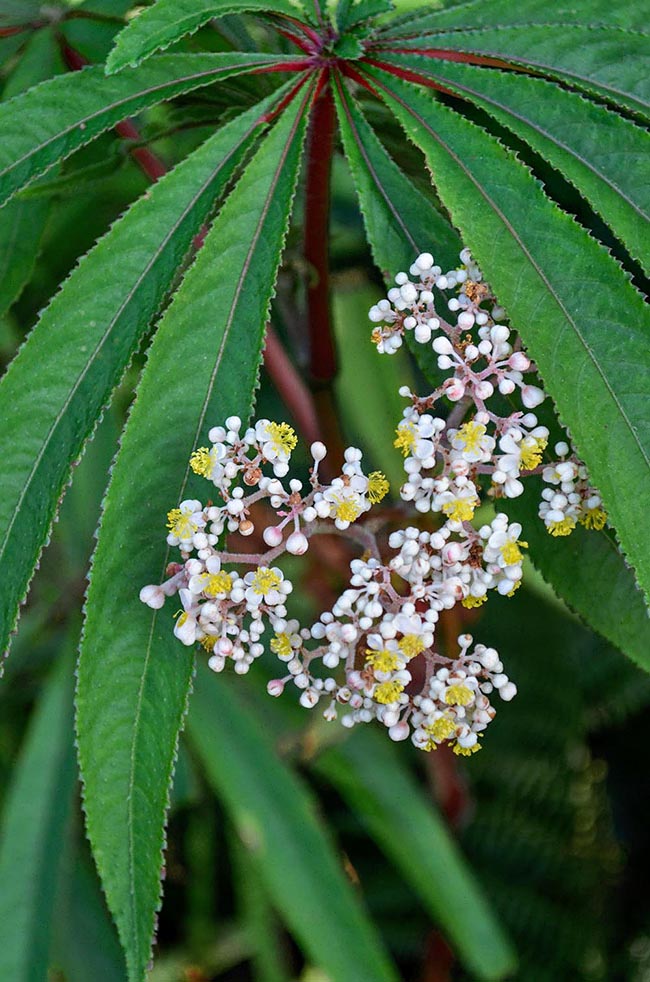
Begonia luxurians is a species native to the Brazilian rainforests, where it can also reach the height of 2,5 m © Charlie Pridham
The Begonia malabarica Lam., present in India and in Sri Lanka, is traditionally utilized against hypoglycemia, as antimicrobial, for healing the wounds and in the treatment of anemia.
In laboratory, watery extracts of leaves have shown a good antimicrobial activity against Aspergillus niger and Vibrio cholerae, in the stem and in the foliar petioles have been found flavonoids, carbohydrates, proteins, steroids, resins tannins and thiols and in the leaves, whilst in the fruits flavonoids, alkaloids, phenols, saponins and tannins.
In Nepal Begonia hatacoa Buch.-Ham. ex D.Don, perennial herbaceous with alternate leaves and white hirsute petioles densely brown and flowers with pink bands, is utilized for the juice of the rhizome useful to kill the intestinal worms.
Begonia josephi A. DC., present in central and southern Nepal between 1000 and 2700 m of altitude, is a perennial acaulescent herb with globose tuber and peltate leaves and white or pink flowers, whose buds are eaten raw or fermented like pickles.
Begonia picta Sm. is a herbaceous species growing in the high Himalaya mountains on the shady banks, on the rocky ledges of the humid zones up to 2800 metres of altitude. It has heart-shaped leaves, of green colour, with violaceous veins, and pink flowers that open in late summer-early autumn.
The tender shoots and the flowers are, in India, fermented to be consumed as pickles. In some Indian sites they consume the raw or cooked leaves because of their delicious sour taste.
The juice of the plant is drunk also for relieving headaches and that of the leaves is utilized for treating the wounds on the feet.
The crushed leaves are utilized as compresses for the sore nipples while breastfeeding. The infusion of the root and petioles of Begonia heracleifolia Cham. & Schltdl. are utilized in Central America to treat a variety of dermatological pathologies such as wounds, skin infections (like acne), but also for rheumatisms.
In Malaysia, a small quantity of Begonia fimbristipula Hance is boiled in water and the decoction is utilized to relieve cough, to stop the emission of blood from the respiratory tract (hemoptysis), to treat fever and pneumonia. A paste obtained from the plant itself is applied on the parts swollen due to distortions and burns. In Papua New Guinea, the sap is collected from the leaves of Begonia augustae Irmsch and used as a remedy to soothe the inflamed zones.
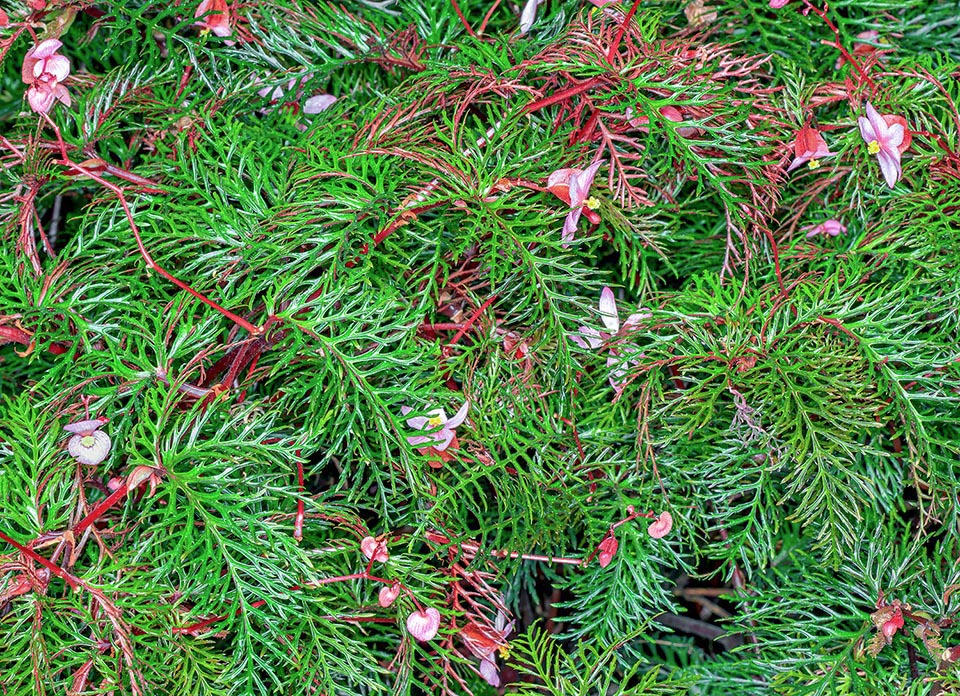
The New Guinea Begonia bipinnatifida has erect, ramified stems, of intense red colour, zigzagging between nodes. Due to the doubly pinnate leaves resembles a fern © Giuseppe Mazza
In the Philippines, the leaves of Begonia oblongata Merr. are utilized to counteract the toxic effect of oxalates of some species of Dioscorea.
The roots of Begonia grandis subsp. sinensis (A.DC.) Irmsch. are used in China to treat burns. Russian researchers have proved the antimicrobial properties of B. grandis Dryand. due to the presence, in extracts of leaves, of phenolic compounds, including the flavonoids, terpenoids, and the carbonyl compounds that, in laboratory, have been active on microbial strains (Bacillus subtilis, Staphylococcus aureus) and on fungal microorganisms (Candida albicans).
In Malaysia, leaves of Begonia isoptera Dryand. ex Sm. are crushed and are applied externally to relieve the discomfort due to enlarged spleen, whilst in Yunnan (China), the water of the boiled leaves is drunk to treat cancer. In fact, several are the species of Begonia (i.e. B. plebeja Liebm. ) that in the laboratory have shown to be cytotoxic against the melanoma, the kidney and the brain tumors.
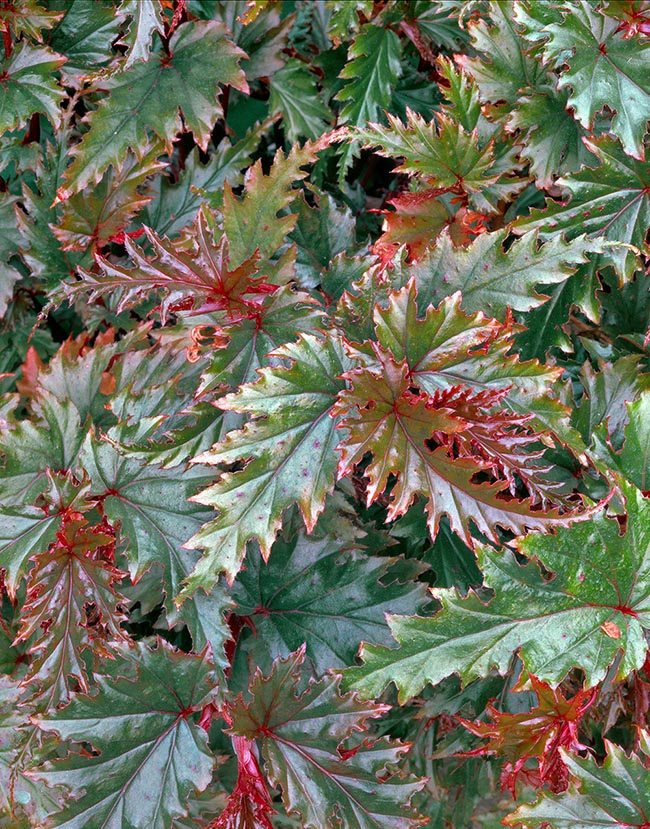
The unusual Begonia serratipetala, native to New Guinea too, has leaves curved between the veinings, of colour tending to dark brown or red violet, with dots intense pink when the light is very strong © Giuseppe Mazza
The decoction of the rhizome of Begonia veitchii Hook. f. in the Province of Paruro (Peru) is used as urinary, intestinal and hepatic anti-inflammatory, and if drunk on empty stomach, as laxative. The whole rhizome is utilized as food.
Very many species and more than 10.000 hybrids and cultivars of the genus Begonia are ornamental and consequently important economically.
They can be cultivated as bedding plants, in planters, in hanging baskets and in other containers, but also in pots inside our flats.
Most of the cultivated species come from very warm regions, in fact, they are underwood plants of the tropical forests, it is consequently necessary to grow them in luminous shade and only few of them will stand the full sun, especially in the warmest climates. Generally, the begonias require a well-drained soil that has not to be constantly watered but not left to dry up completely. Many begonias will grow and will flower all the year round but the tuberous begonias that usually have a period of dormancy. During the period of latency the tubers can be conserved in a cool and dry space.
In the temperate climates the begonias can be cultivated in open air as annual plants or as indoor or greenhouse plants. The best temperature for most species stands between 15 and 18 °C. If grown in house, we have to avoid putting them close to radiators, but to keep them in spaces where the temperature does not exceed the 18 °C and where the atmosphere has a certain humidity. In fact, begonias require a lot of humidity, but attention is to be paid to avoid stagnations as these might favour the development of fungi on the leaves such as the grey mould (Botrytis cinerea Pers.). Bacteria such as Xanthomonas axonopodis pv. begonia, can cause the drying up of the leaves and the presence of aphids manifests with turning yellow leaves and fall of the buds. Also viruses can cause distortions to the leaves and damages to the entire plant. Depending on the nature of the various species, the multiplication of begonias may occur by non-floriferous cuttings or by leaf in early summer by division of the rhizomes in spring, by division of the tubers in spring or by seed in late winter.
Traditionally, the growers divide the species of Begonia interesting them in three groups. One is cultivated for the leaves, especially B. rex and his varieties and hybrids. In another group stand the begonias with small flowers like B. cucullata Willd. (known as B. semperflorens Link & Otto) as well as with big flowers, among which the tuberous begonias, like B. rosaeflora, B. veitchii, B. boliviensis A.DC. and B. × tuberhybrida Voss. In a third group are those with very ornamental flowers and leaves such as B. scharffii Hook.f. and B. aconitifolia A.DC.
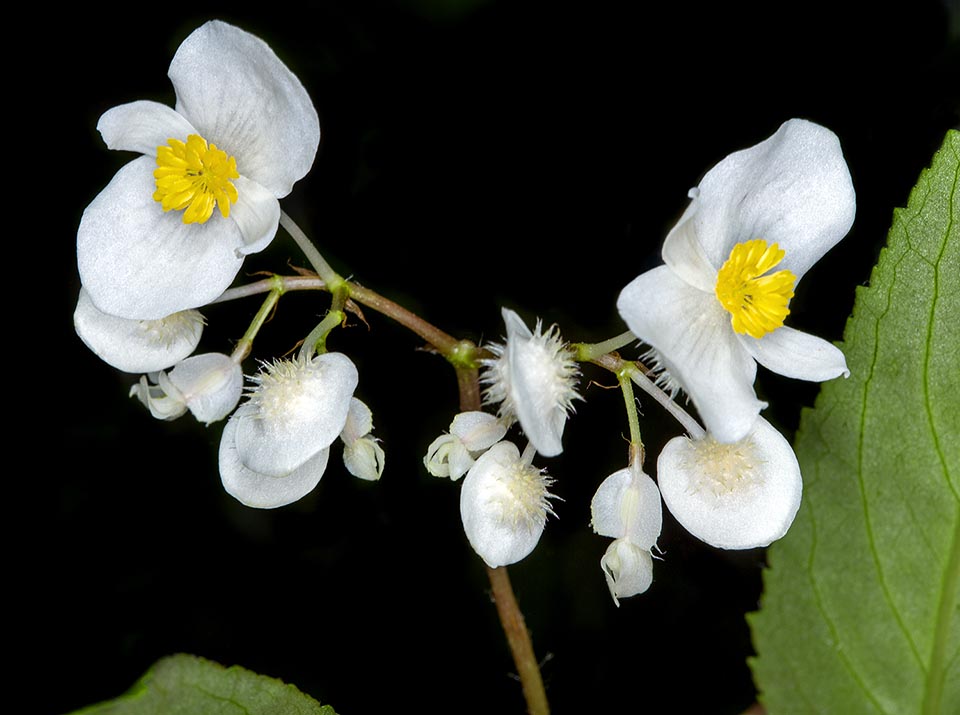
Begonia echinosepala male flowers, endemic of south-east Brazil, with 4 tepals. The outer ones have the back covered by thorn-like protrusions © Giuseppe Mazza
The American Begonia Society, founded in 1923, has proposed a new subdivision of the cultivated begonias dividing them in eight groups: 1) group of Cane-like, 2) Shrub group, 3) Rhizomatous group, 4) Semper florens group, 5) Tuberous group, 6) Rex group, 7) Trailing – Scandent group, 8) Thick stemmed group.
Group of the Cane-like begonias
These are begonias with high and robust stems, with nodes and internodes that recall the bamboo canes. We cite Begonia × albopicta W.Bull, known as “tamaya”. It is native to the tropical forest in Brazil and has rigid stems, up to 90 cm tall, 15-30 cm leaves of eccentric shape, of green bottle colour, silver dotted, and flowers of coral colour in elegant pendulous inflorescences. It is an indoor plant cultivated especially for its decorative foliage.
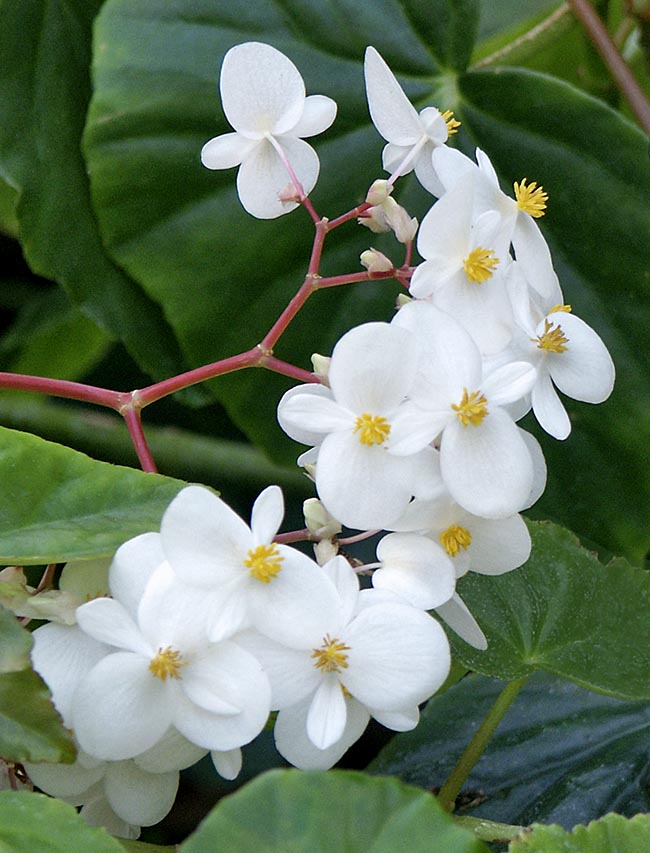
Begonia odorata ‘Alba’, with elegant inflorescences of weakly perfumed wite flowers, is a perennial bushy variety with glossy succulent leaves,. Native to Caribbean, grows well in the shade but bears also the full sun © Scott Zona
Begonia aconitifolia A.DC. known as Angel wings begonia, grows quickly forming a dense bush rich in ramifications with blue green leaves, lobate, ovate and speckled with silver that recall those of the aconite, hence the name. It has white and pink hanging flowers and reaches the height of 3 m.
Begonia maculata Raddi (= B. corallina Carrière) is a shrubby plant with high and woody stems and prominent articulations, similar to bamboo, native to Brazil, where it can exceed the metre of height with the numerous persistent leaves that reach the 20 cm, of dark green colour, dotted by irregular spots on the upper lamina and red in the lower one. The flowers are white in large inflorescences. It is a shade or mid-shade plant, easy to cultivate provided we have the foresight of leaving the loam to slightly dry up between the waterings.
Shrub group
Various are the species of Begonia that are shrubby with a high number of stems. They are mainly cultivated because of their nice foliage.
Among these we cite Begonia incarnata Link & Otto, an evergreen plant of Central America, up to one metre tall, with big asymmetric leaves and of green colour having a metallic sheen. The flowers are small, of pink colour and hairy. In cultivation it does not stand temperatures lower than 10 °C. Because of its beauty it got the award “Garden Merit” by the Royal Horticultural Society.
Begonia odorata ‘Alba’ is a perennial bushy variety with glossy leaves, succulent and with elegant inflorescences of white flowers weakly scented. This begonia, native to the Caribbean, is known for its capacity of standing in the strong sun and behaves well also in the shade. It can be cultivated in soils averagely humid and slightly acidic, provided well drained, or in hanging baskets or in containers for covered porches.
Begonia bipinnatifida J.J.Sm. is a shrub with erect stems, ramified, of intense red colour, zigzagging between the nodes. The leaves are up to 12 cm long and 5 cm broad. The upper lamina is of intense green colour whilst the lower one is of intense red. The leaves are doubly pinnate, resembling those of a fern. The flowers are small, the male ones with two pink tepals shaped like kidneys, the female ones have five equal tepals also of pink colour, oblong or elliptic-obtuse. The styles are erect, filiform, divergent, yellow. The stigmas, also of yellow colour, have the shape of a twisted half-moon. The ovary has three wings and is of intense pink colour. This species is quite difficult to cultivate, requires a lot of ambient humidity, must be watered carefully and fertilized regularly.
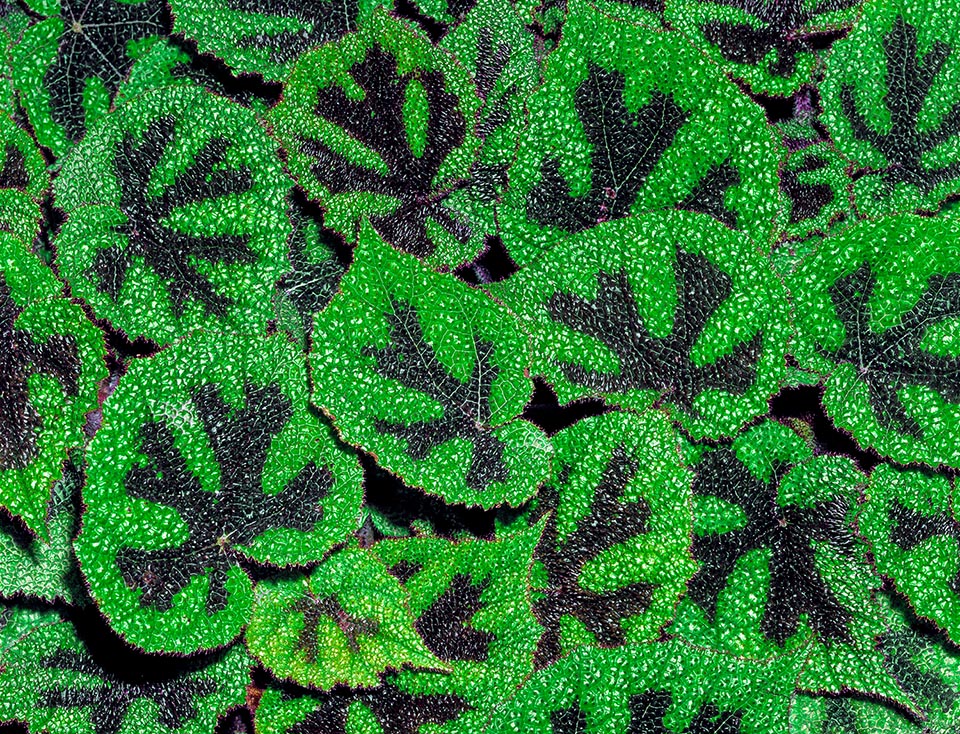
Known indoor plant, Begonia masoniana is a rhizomatous of tropical Mexico up to 50 cm tall. The big asymmetric leaves, covered by reddish hairs, are of a nice emerald green colour with prominent dark pattern at the centre recalling the Iron Cross of the Kingdom of Prussia. The modest flowers are tiny and white © Giuseppe Mazza
Begonia echinosepala Regel, is a shrubby species endemic to South-East Brazil, where it grows only in the Atlantic Forest in the bottom of the valleys, on slopes and rocks little exposed to the rainwater runoff and in the rocky zones near small water streams. It can reach 180 cm of height and has stems with up to 5 cm long internodes.
The leaves are green and elongated, oblong to linear and measure 7-8 cm of length and 2-3 cm of breadth and have asymmetric base, acuminate apex and ciliate and toothed margin, with a thin red-pinky border. The petiole is slightly hairy and forms a right angle in respect to that of the leaf. The stipules are persistent, erect, oval to lanceolate. The flowers are white, arranged in pauciflorus cymes. The male flowers have 4 tepals, the 2 external are orbicular and with the back covered by soft thorn-like protrusions, from which comes the name of the species, the inner ones are obovate. The stamens have yellow prominent anthers. The female flowers have 5 unequal tepals and 3 yellow styles, spirally intertwined. The ovary is inferior, trilocular, oblong, with three wings. The fruit is a trilocular capsule, oblong, crossed by three unequal wings. The pollination occurs through bees.
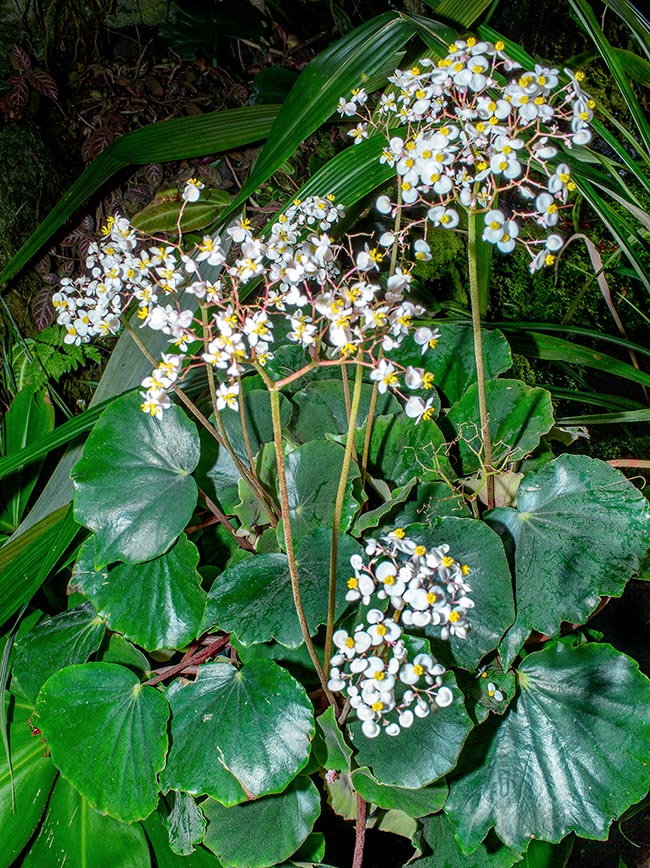
The Begonia floccifera, native to Indian altitude forests, is a rhizomatous species with big orbicular levas, cordate, up to 18 cm broad. The rich inflorescences are are compound cymes up to 30-45 cm long © Giuseppe Mazza
This species was introduced in horticulture in 1871 with production of several varieties, such as B. echinosepala var. elongatifolia characterized by small leaves, numerous flowers, fragrant and white. It is probably one of the begonias most diffused in cultivation.
Begonia luxurians Scheidw is an evergreen species, native to the Brazilian rainforests, that can be 2,5 m tall. It has rigid stems, erect, ref-purple, surmounted by long palmate leaves , about 25 cm broad, each divided in lanceolate and hairy leaflets, of intense green colour with reddish shades in the lower lamina. The flowers, arranged in cymes, are small, perfumed, of pale yellow to white colour and rise above the leaves from spring to summer. This species has been awarded the “Garden Merit” by the Royal Horticultural Society. In cultivation it requires dappled sunlight or bright shade and fertile soil, well drained but maintained uniformly humid that must not dry up, better if in containers that allow its winter sheltering because it fears the frost.
Begonia serratipetala Irmsch is a plant with bushy posture, up to 50 cm tall, with erect and leafy stem, native to New Guinea. The leaves, with the surface curved between the veins, are lanceolate, with serrated edges and of dark bronze or red-violet colour with pink spots that get more marked in conditions of very strong light. The flowers are small, intense pink, on short peduncles, in open inflorescences. In cultivation it is better to use a well draining loam and to keep it in ambient having high humidity.
Group with rhizomes
They have enlarged stem, underground, erect or creeping and are cultivated due to the elegance of the leaves and, sometimes, of the flowers. A very nice perennial plant up to 90 cm tall is Begonia masoniana Irmsch. ex Ziesenh. It has big leaves, asymmetric, covered by reddish hairs, of nice green colour with a prominent dark brown pattern in the centre of each leaf, that recalls the Iron Cross of the Kingdom of Prussia. The flowers are small, white, arranged in erect panicles. It is cultivated, almost exclusively, for its nice foliage. It does not love cold, therefore in temperate climate regions its cultivation must be done in a greenhouse or at home. Another species of this group is Begonia bowerae Ziesenh of tropical Mexico. It is evergreen, rhizomatous, and creeping, 25-30 cm tall, and is mainly cultivated for its heart-shaped leaves of emerald green colour with chocolate coloured dots and bristles on the edges. It produces loose clusters of pink coloured white flowers that rise over the foliage in late winter and in early spring. It is an excellent indoor plant, in pots or in hanging baskets, thanks to its colours and its relatively fast growth. Moreover, it can be cultivated also in open air during the whole year in the zones with mild winters, where there is no frost, to form a nice carpet on the meadow. It prefers the partial shade and soils organically rich and well drained.
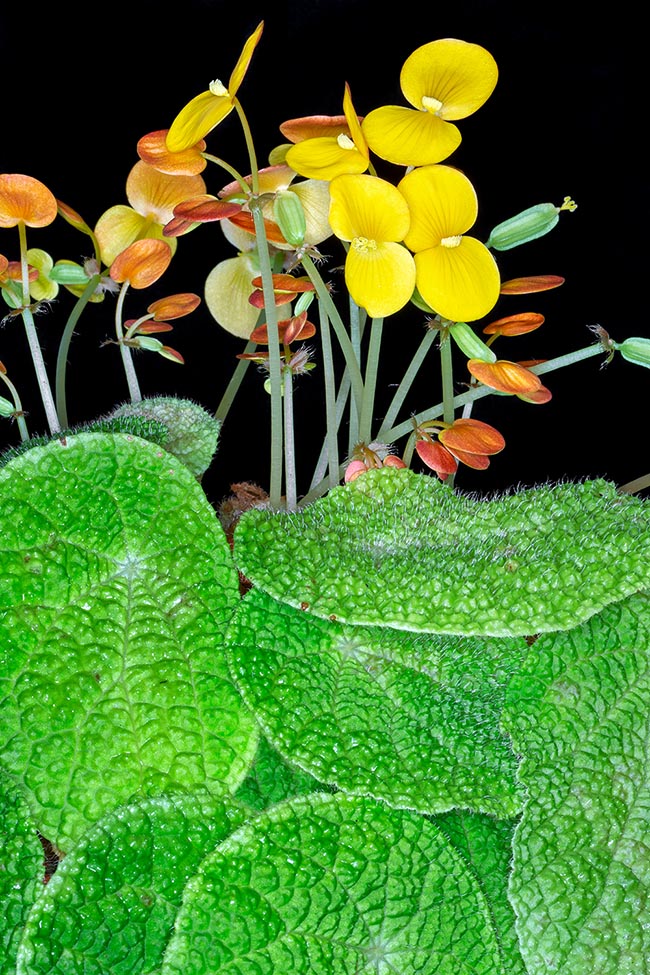
Very appreciated by collectors, due to its moderate growth and the relief texture of the leaves, Begonia staudtii is a rhizomatous species native to Nigeria and west Cameroon. Grows on sandy soils and on rocks, or, as epiphyte, on trunks of trees. The unusual tiny flowers have 2 tepals and colours varying from yellow to orange © Giuseppe Mazza
This begonia requires high humidity during its growth but between one watering and the next one the loam must be allowed to dry up. The excessive irrigation may cause fungal diseases and rottenness. It multiplies by cuttings or by sections of the rhizome.
In 2005, two Taiwanese botanists described a new species found in the Chuyunshan Mountain, which means “Mountain over the clouds”, in Taiwan. It is the Begonia chuyunshanensis C.I Peng & Y.K.Chen., perennial herb 40-85 cm tall with erect stems, little developed rhizomes, creeping or absent. The leaves are oblique, unequal, cordate at the petiole, lanceolate to ovate, 9-18 cm long and 4-7 cm broad. The petiole is glabrous, 6-30 cm long, of up to 8 mm of diametre. The inflorescences are 5-16 cm long, axillary, with white or slightly pink flowers. The male flowers have 4 tepals transversely arranged, and yellow clavate stamens, the female flowers have 5(6) obovate or largely ovate tepals with pistils having 3 yellowish stigmas. The fruit is a tricuspid loculicidal capsule with 3 triangular wings, unequal and containing numerous seeds. This species, rare in cultivation and resistant to -8 °C, requires a partial shaddy ambient in a cool position and sheltered, in humid soil, rich in humus and well drained.
Begonia aptera Blume is diffused in most of South-East Asia (Java, Indochina and western China (Yunnan and Hainan). It grows in the underwood at altitudes from 500 to 2.000 m. It is a rather succulent plant with rhizomatous roots. The stem is glabrous, robust, ramified, up to 1 m tall. The leaves are alternate, oblong, 15-20 cm long and 5-7 cm broad, acuminate at the apex, cordate or auricolate at the base, toothed at the edges, of bright green colour in the upper lamina and dull grey in the lower one. It is a monoecious species with flowers present from May to September and arranged in axillary clusters. The male flowers, white or pale pink, have 4 tepals, the external ones are bigger, and numerous yellow stamens. The female flowers, white or pale pink too, have 6 tepals and an inferior ovary surmounted by 3 bifid styles at the apex and papillose and spirally feld. The fruit is a capsule similar to a berry, without wings, weakly globose. The seeds are minute and very numerous.
Begonia floccifera Bedd. is an evergreen herbaceous species, rhizomatous, acaulescent, up to about 25 mm tall. It has reniform or orbicular leaves, cordate, up to 18 cm broad, toothed at the margins, pubescent in the lower lamina, glabrous and of intense green colour in the upper one. The inflorescences are compound cymes, 30-45 cm long. The flowers appear in spring, the male ones have 2 white tepals and numerous stamens with the anthers truncated at the apex and the female ones 4 white tepals and ramified stigmas. The ovary is inferior, with three wings forming 1,3×1,5 capsules containing small brown seeds. This species lives in India, in the humid forests at about 1000 m of altitude.
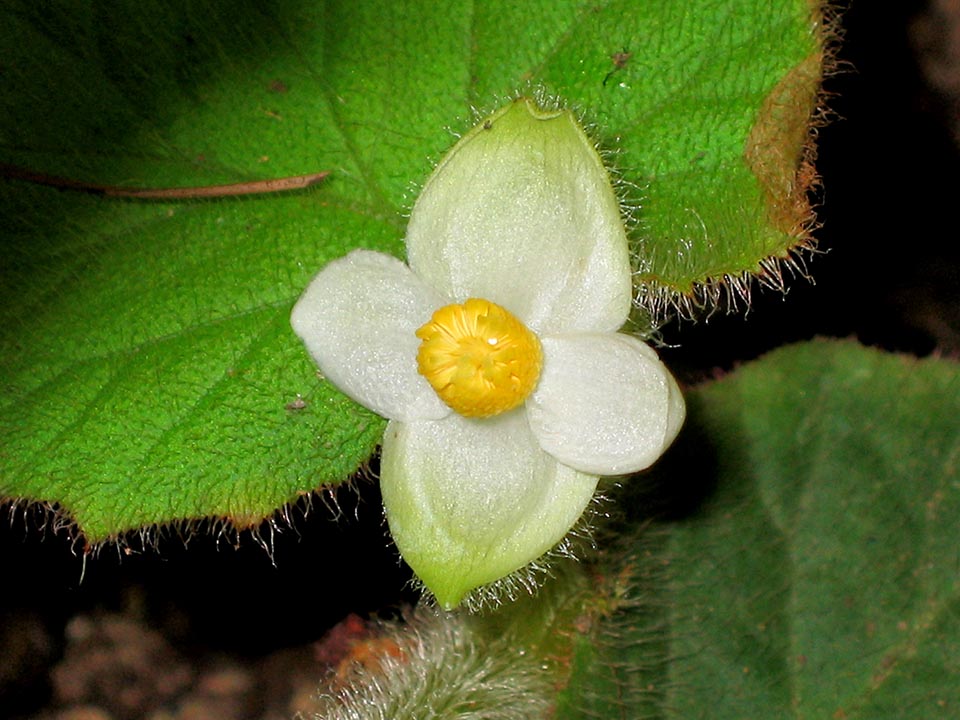
Begonia villifolia is a rhizomatous species, native to Yunnan forests, growing on rocks and shady humid slopes or along the streams at 1600-1700 m above sea level © 阿 橋
For its cultivation, we suggest a well drained loam with humidity from 65%-85%, temperature of 15-20 °C and a half-shade exposition. If cultivated indoors, the natural light of a window facing west, as well as the irrigation with a liquid fertilizer, diluted when the loam is dry, favours its blooming starting from April.
Begonia staudtii Gilg (= Begonia staudtii var. dispersipilosa Irmsch.) is a rhizomatous species, native to Nigeria and western Cameroon. It grows in sandy soils and on rocks, or, as epiphyte, on trunks of trees, in areas with high humidity, often close to streams and rivers. It has up to 12 cm tall stema, with peltate leaves, oval, acuminate, of medium size, having the upper lamina with small outgrowths covered by white transparent hairs and the lower one with red hairs resembling thorns. The young leaves are, usually, covered by white hairs. The male and female flowers have two petals and colours varying from yellow to orange. It is a very appreciated plant by the collectors, with moderate growth, due to the relief texture of its leaves.
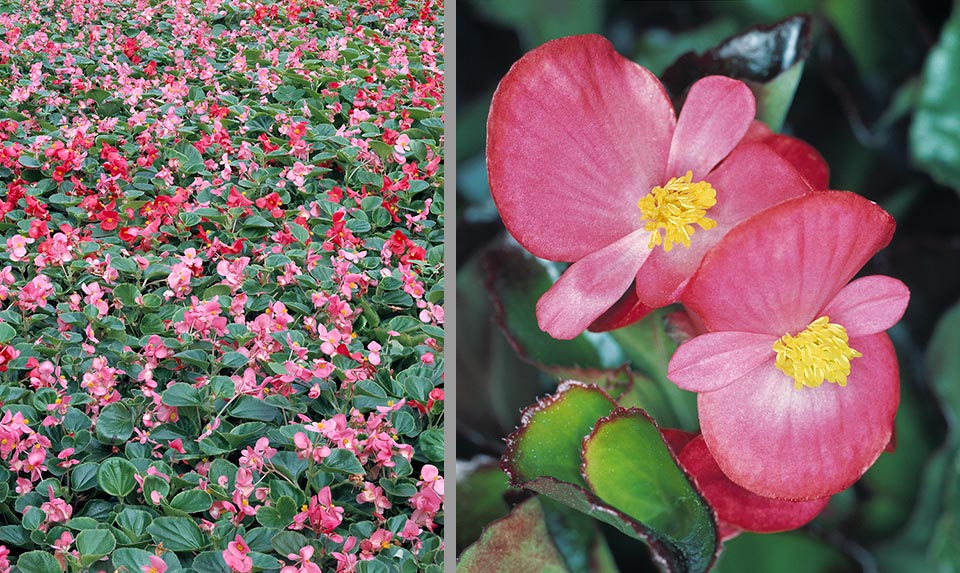
To the Group Semperflorens belong begonias very diffused in cultivation, known as “waxy begonias” or ‘begonias semperflorens” for the waxy look of the leaves and the continuous abundant blooming. Varieties grown as annual for splendid flowerbeds, born from old hybrids of Begonia semperflorens, now synonym of Begonia cucullate © Giuseppe Mazza
Begonia villifolia Irmscher is a herbaceous plant growing on rocks of the humid shady slopes or along the streams at 1600-1700 m of altitude in the forests of Yunnan (southern China).
It has little developed rhizomes and up to 80 cm tall stems. The leaves, supported by up to 36 cm long petioles, have oblong-ovate membranous stipules and ovate lamina, asymmetric, 9-34 x 7-25 cm, villous, with serrate margins and palmate veins. The inflorescences are 5-6 cm long, densely villous and with deciduous bracts. The male flowers have 4 tepals, white, villous with numerous stamens and free filaments with elliptic anthers. The pistilliferous flowers stand on 1-2 cm peduncles and have 5 tepals of variable size, villous. Also the ovary is densely villous with 2 styles fused at the base and stigmas with 2 fissures.
The fruit is an ellipsoid capsule, with three unequal wings, the lateral ones are smaller than the central. This plant blooms from May to July and bears fruits by late July.
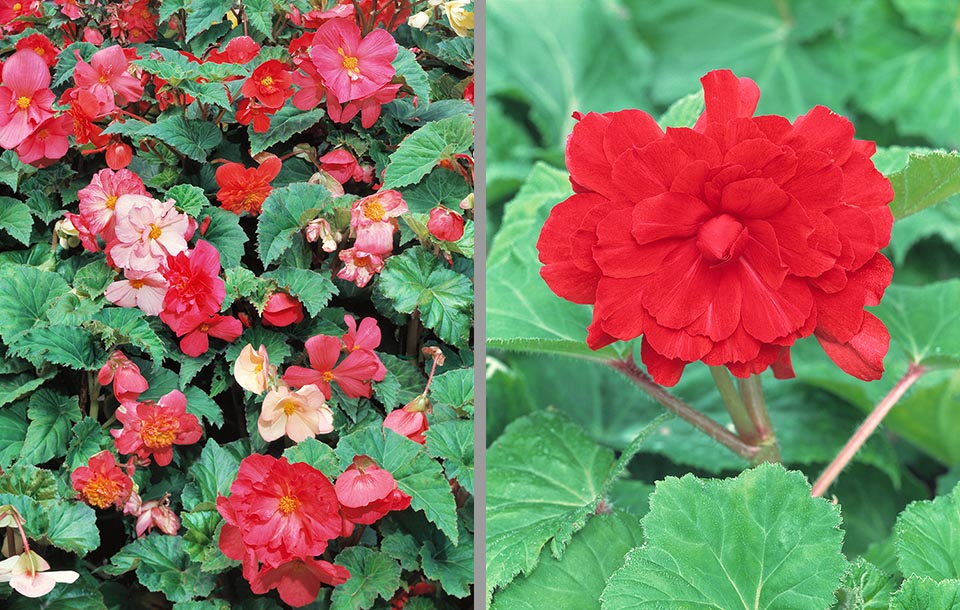
Begonia x thuberhybrida is the most diffused tuber variety, with big flowers, often double and of bright colours. Rests in winter, but reappears in spring from big tubers © Giuseppe Mazza
Group semperflorens
To this group belong begonias very diffused in cultivation mainly because of the waxy look of their leaves and for this reason called “waxy begonias” but also “begonias semperflorens”.
These are begonias that have been hybridized over the years utilizing as progenitor the species Begonia semperflorens Link & Otto, nowadays synonym of B. cucullata Willd . The many cultivars derived from this species are cultivated as flowerbed plants annual in the cold climates, perennial and under the form of small shrubs in areas with tropical and mild climates. They have shiny leaves, fleshy, mostly of two colours, green and bronze, but do exist variegated types and also with young white leaves.
The flowers, double at times, are small, with 4 flesh tepals, of white, pink or red colour that are found on the plant at the end of spring until early autumn.
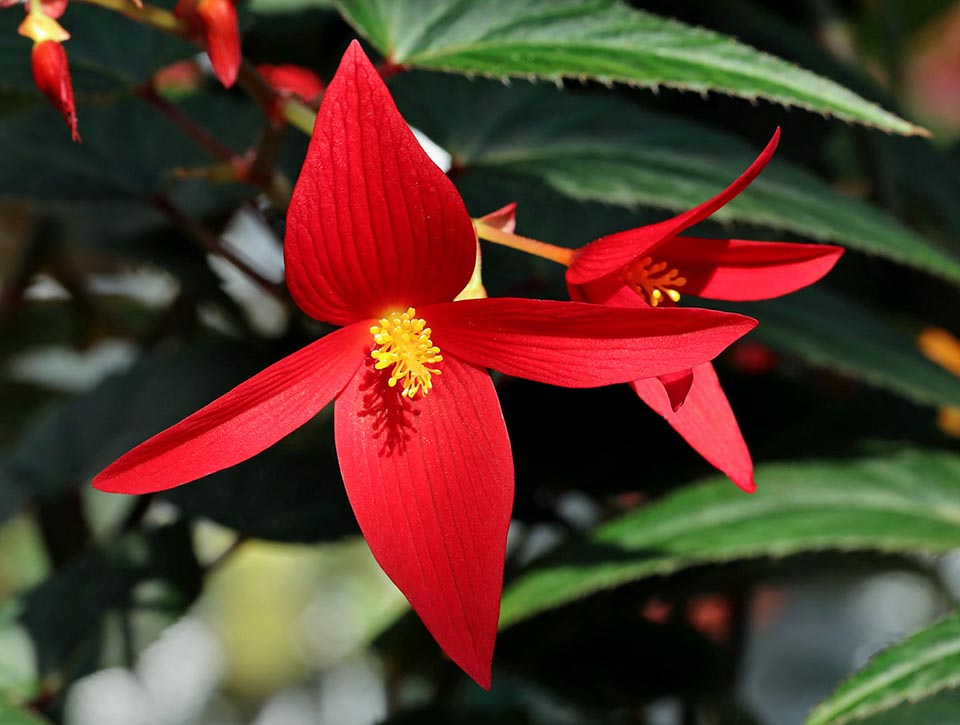
Begonia boliviensis is a species native to the Andes mountain rainforests. The stems, with flowers in clusters, get out from a tuber and can reach the 45 cm © Ashitaka-f
Another species inserted in this group is Begonia subvillosa Klotzsch (= B. schmidtiana Regel), a small plant native to Brazil, characterized by many branches with hairy leaves, of dark green colour, and white to pink flowers, present on the plant from spring to autumn.
Group with tubers
These are begonias characterized by a big tuber, from which in spring forms the new vegetation whilst in winter they go to rest. To this group belong the many hybrids (Begonia × tuberhybrida Voss), cultivated for their summer bloomings with shiny colours. They are plants known all over the world and employed to form flowerbeds in temperate climates, or as greenhouse plants or as indoor, in the cold ones. Generally, they are cultivated for the beauty of their flowers, but sometimes also for their leaves. The flowers can be simple or double and of many colours. There is also the semi-tuber type that has no tuber but a stocky and enlarged stem, shaped like a flask, that acts as a reserve organ.
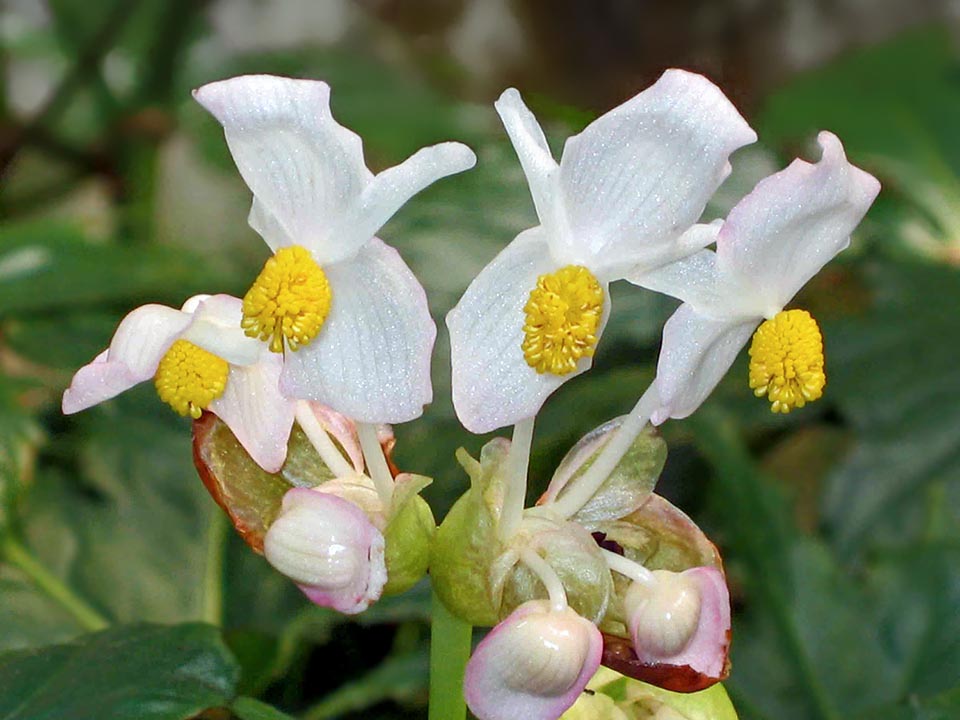
Similarly tuberous, Begonia miranda is native to the mountain forests of Yunnan. It grows in humid sites on the rocky slopes or in deep valleys at 1200-1600 m of altitude © 阿橋
Usually these are plants with small leaves and white, at times pink, flowers. They look like natural bonsais due to the swollen base that bears the small stems and the leaves.
Begonia bufoderma L.B.Sm. & Wassh has big, elongated leaves that reach even 40 cm of length, of intense green colour, rough to touch. The flowers are white-greenish and scented.
Begonia boliviensis A.DC. is a very interesting species, native to the mountain rainforests of the Andes in Bolivia and in Argentina. It grows in the fissures of the rocks and in the slopes near water streams. The stems generate from a tuber and may reach 45 cm. The flowers are arranged in clusters that hang from the axils of the upper leaves and have 4 drooping tepals with lively colours (usually red or orange), that contribute to the drooping effect of the plant. It can be cultivated as a pots plant or, in the mild climates, in the gardens. Several varieties and cultivars do exist.
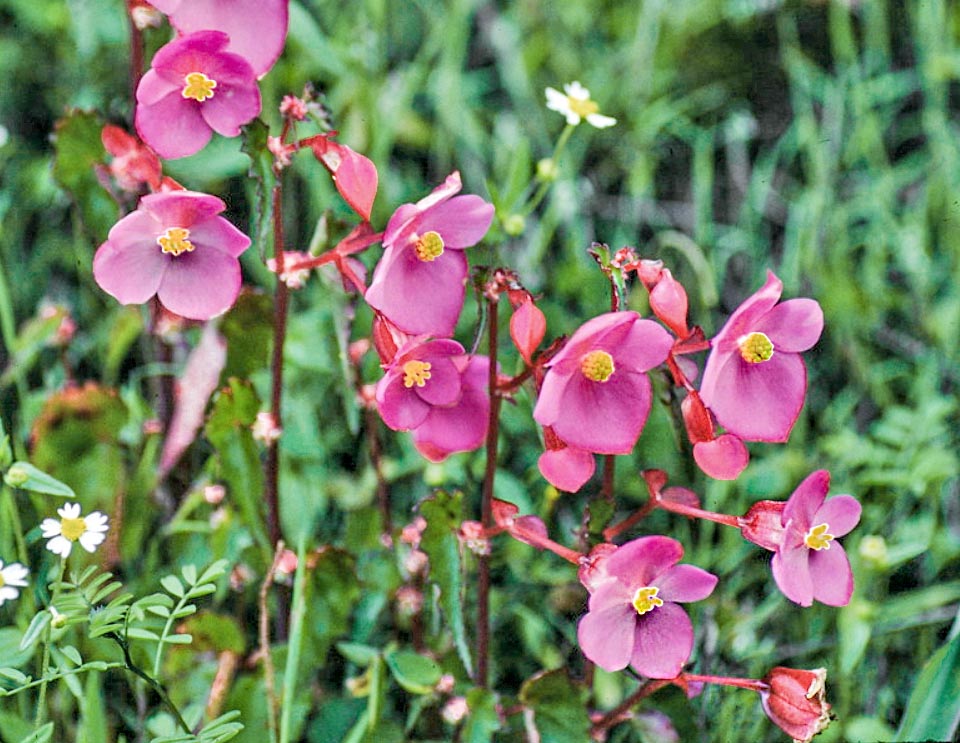
Begonia gracilis grows in the Mexican mountain mesophyllic forest between 2000 and 2600 m of altitude, reappearing due to the tuber after the bad season © Mark Egger
We mention here B. boliviensis ‘Copacagana’ with flowers of red, salmon or orange colour, very resistant to diseases and tolerant, also of the full sun. The cultivar B. boliviensis ‘Bonfire’ grows well in containers or in suspended baskets and reaches a height of 60 cm. It has bright orange flowers, bell-shaped, that cover the plant from late spring to summer.
Begonia miranda Irmsch is native to Yunnan (China) and grows in humid locations, on the mountain slopes or in valleys of forests from 1200 to 1600 metres of altitude. It is an averagely-sized herbaceous plant. The rhizome is almost spherical, of 1-2 cm of diametre. The leaves are big (16-21 cm), all basal, with ovate, almost round, margins supported by a 28-32 cm long petiole. The veins are covered by long hairs, denser close to the petiole; the stipules fall soon. The floral scape can be 28 cm tall, thin and weak, with pink flowers. The male flowers have 4 tepals and many stems, the anthers are wedge-shaped obovate; the female flowers have 6 tepals.
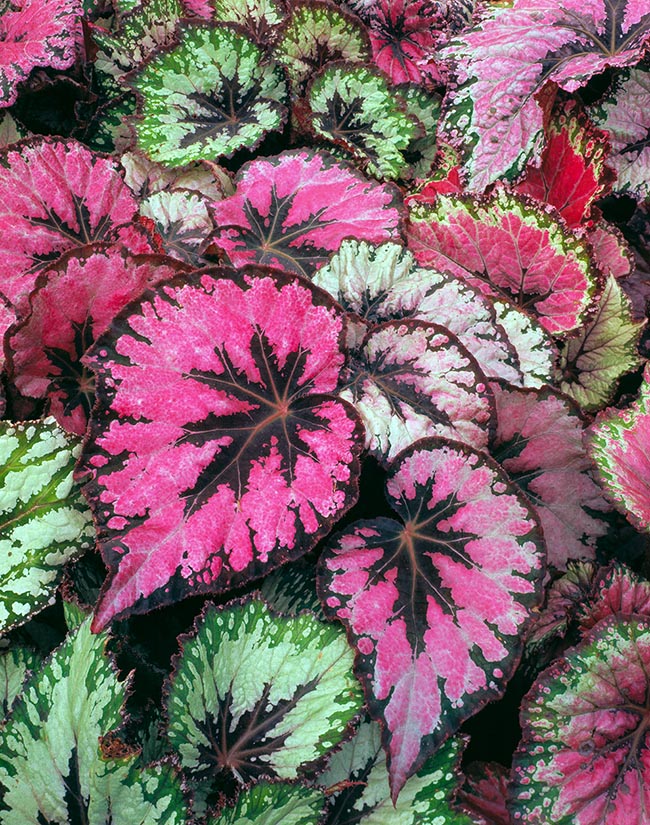
Begonias rex form a group cultivated mainly for the beauty of the leaves. The countless hybrids are born from various crosses with rhizomatous species of the Begonia rex, native to north-eastern India, Vietnam and southern China, where grows in the shade of forests or at the entrance of grottoes and ravines, at 4000 m of altitude © Giuseppe Mazza
The fruit is a drooping capsule supported by a 2,5-3 cm long peduncle with 3 wings of about 1,5 cm, one shaped like a tongue, the two others are crescent shaped. There are many seeds, small, pale brown, smooth. This species blooms in October and fructifies in November.
Begonia gracilis Kunth lives in the Mexican mountains in the mountain mesophyllic forest, between the 2000 and 2600 m of altitude.
It is an evergreen herbaceous plant, up to 50 cm tall, with tuberous base and pubescent or glabrous stems, often having bulbils at the axil of the leaves.
The stipules are persistent, green, and the thin petioles that bear leaves, of green-brown colour, ovate or elliptic (heart-shaped), with wavy margins.
The flowers form in the beginning of summer. The ùmaleones, on reddish peduncles, have 4 tepals, glabrous, of pink colour, with numerous stamens on a short column. The female flowers have 5 tepals and bifid styles.
The fruit is an ellipsoid capsule with three unequal wings, the greatest being triangular and the other two crescent-shaped. When ripe, the capsule frees many small seeds.
Begonia veitchii Hook.f. is a species native to Peru, Bolivia and part of Argentina.
It grows on shady rocks, on rocky slopes and old walls, located at the foot of the Andes Cordillera at altitudes between 2000 and 4000 m
They are perennial herbaceous plants, with reduced or absent aerial stems and with tuberous roots. The leaves, supported by short and robust hairy petioles, are of dark green colour in the upper lamina and clear green in the lower one, with red and ciliate margins. The scape is erect, in an almost circular section, with membranous, oblong, red-pink bracts.
The flowers are of vermilion red colour, the male ones bigger than the female, with 4 ovate tepals and numerous stamens, the female ones with 5 tepals, inferior ovary and trifid style. The fruits are capsules. This species, collected in the Peruvian Andes, close to Cusco (south-eastern Peru) by the botanist and collector Richard Pearce (1835-1868), by him was introduced in England in 1866 and soon crossed with other species (B. boliviensis, B. pearcei Hook.f.). The crosses have originated numerous garden hybrids (B.× tuberhybrida) with big flowers and variously coloured (white, yellow, orange, fuchsia, yellow-orange, etc.).
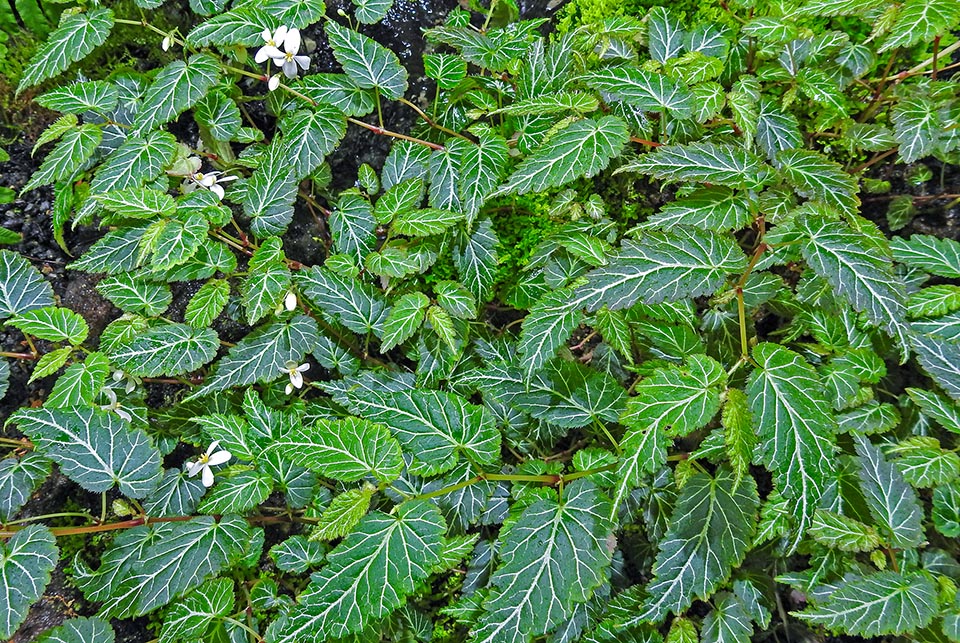
Begonia vareschii, native to Barinas state (Venezuela) rocky and humid gorges belongs to the climbing and drooping Begonias group © René Stalder
Group Rex
In this group (also called Begonia rex-cultorum) is inserted Begonia rex that is the most diffused and known species. It is native to north-eastern India, Vietnam and southern China, where it grows under the forests or at the entrance of grottoes and clefts, at 4000 metres of altitude. It is a herbaceous species that can reach the height of 40 cm. It has elongated rhizomes from where originate directly the big asymmetric leaves, up to 30 cm long and 20 cm broad, with an oblique heart-shaped base and with the greater lobe overlying on the smaller, with serrate and ciliate edges and pointed apex. The upper lamina is green with a large silvery spot shaped like a horseshoe (in the garden cultivars, there is a variety of colours with pale green, grey, silver, red, shiny pink variegations), whilst the lower one is, usually, of violaceous red colour. The leaves are supported by up to 35 cm long petioles. The flowers are rather inconspicuous, usually of pink colour. The male ones have 4 tepals, the two external oval or oblong, the inner two narrow.
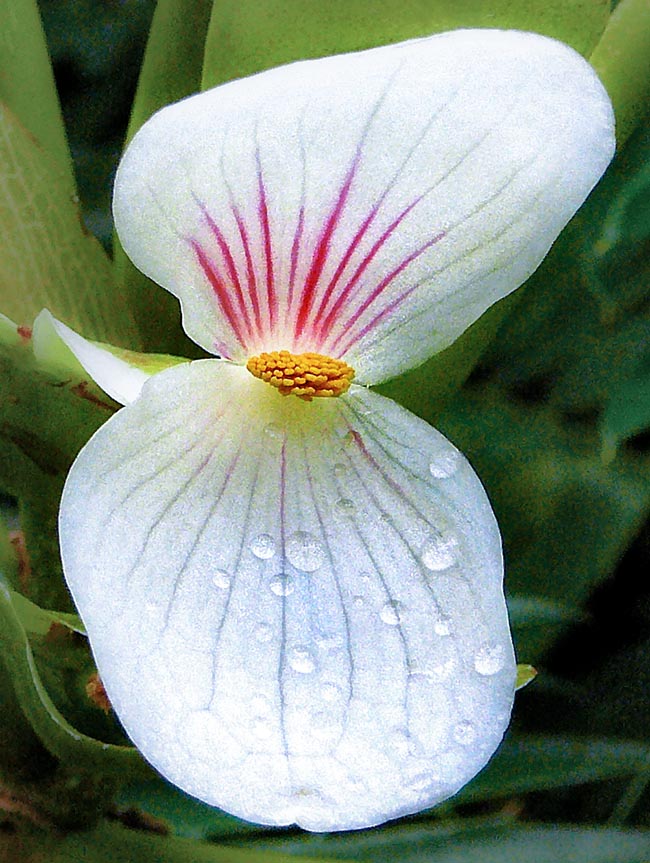
Begonia ampla is a climbing epiphyte of Equatorial Guinea. Grows in the humid forest at 1200-1800 m of altitude with creeping stems, rooting at the nodes, even 2 m long. The two tepals of male flowers, pink or white, often show dark pink longitudinal veins. The white or orange fruits are fleshy and indehiscent, like a berry © Robert Combes
The stamens are numerous with prominent yellow anthers.
The female flowers, supported by peduncles, have 5 unequal tepals, elliptic or largely oval, 2 styles and spiralled stigmas and inferior ovary, glabrous and bilocular. Usually, the blooming takes place in May and the fruitification in August. The fruit is a pendulous capsule, with three unequal wings, the bigger up to 2,5 cm broad and the other two 0,5 cm long.
In this group are included begonias obtained from crosses between B. rex Putz. with other rhizomatous begonias.
They are mainly cultivated as indoor plants thanks to the beauty of the leaves. Among the numerous varieties and cultivars, we mention: B. ‘Curly Fireflush’ with its splendid spiralled leaves, covered by soft pink down and of pale green colour with dark red areas; the interesting B. ‘Venetian Red’, perennial, evergreen plant, rhizomatous, with big grey-green leaves irregularly lobat that become intense red with white veins edged with black.
Drooping and climbing group
The group includes climbing and drooping begonias that are mainly cultivated for the beauty of their flowers, that usually form in spring.
Begonia ampla Hook.f is native to Equatorial Guinea and grows in the humid forest at 1200-1800 metres of altitude. It is an epiphyte that climbs trees or rocks. The stems are creeping and up to 2 m long, rooting at the nodes, usually not ramified, that become woody with age. The leaves are thick and fleshy , of green colour, with pink spots. The inflorescences are axillary, subtended by the persistent bracts, and carry male and female flowers.
The male flowers have two pink or white tepals, often with dark pink longitudinal streaks, the stamens are numerous with filaments free or fused only at the base. The female flowers have 2 pink or white tepals, with briefly stipitate, quadrilocular, without wings, 4 styles, bifurcated at the apex, spirally twisted, with yellow to greenish stigmatic papillae. The fruits develop inside the bracts and when ripe are of white or orange colour, fleshy, indehiscent, like a berry.
Begonia pendula Ridl is a thin climbing plant growing at 250-300 metres of altitude, on the calcareous rocky walls, covered by moss, in the shade of the rainforest in the State of Sarawak (Malaysia). It has very thin and fragile roots, leaves on red peduncles that hang down, shaped like an asymmetric dart, of pale green, at times dark, colour, rarely dotted with white, with hardly visible veins.
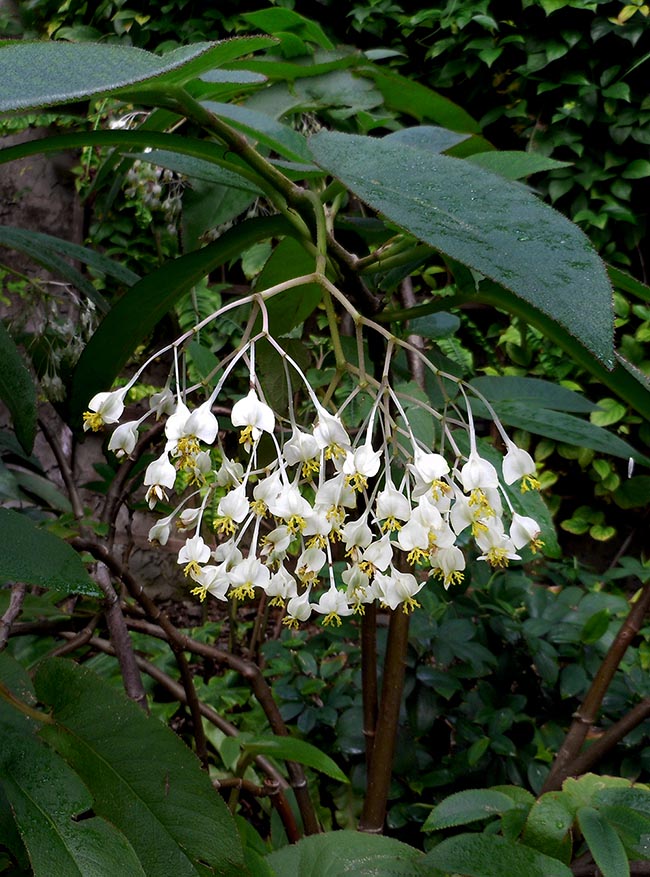
Begonia egregia, inserted in the group of the fleshy stem Begonias, is native to Brazil. 80 cm woody stems and white flowers fused in great clusters opening in spring. It is an easy to grow, cold resistant plant © Mark Housman
The flowers are bright red when still closed, then white, the male ones have 2 tepals, the female 4-5 of them.
This species, described in 1905, must not be mistaken with the horticultural forms of the tuberous begonias with drooping posture, called “pendula”.
Begonia vareschii Irmsch. is a species living in rocky humid gorges in the state of Barinas (Venezuela). It has thin stems rooting at the nodes, and asymmetric leaves, obovate, with acute apex and oblique cordate base, toothed margins, initially yellowish, then dark green with few white hairs and white veins.
The flowers are solitary or coupled at the axils of the leaves, the male ones have 4 ovate tepals and the female, that take form after the male, have 5 oblong tepals.
Group with fleshy stems
The types with thick and fleshy stems are not so vastly cultivated even if they are available in the nurseries under various forms. Most of them do not ramify but form new shoots from the base.
The stems appear thick as the lower leaves fall and usually remain only those at the apices thus rendering these plants very attractive as surely unusual but interesting to cultivate.
Begonia egregia N.E.Br is a fascinating evergreen begonia native to Brazil with up to 80 cm tall woody stems, usually naked but at the apex. The leaves are alternate, big, long and narrow of bright green colour, hairy, and with a reddish edge slightly jagged. The flowers are white, in big clusters, opening in spring. It is a plant easy to cultivate and cold resistant.
Genera: Begonia, Hillebrandia.
→ To appreciate the biodiversity within the BEGONIACEAE family please click here.
